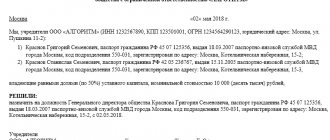Return of the writ of execution to the claimant
The writ of execution may be returned to the claimant after the defendant has fulfilled all the requirements specified in the document, or without execution of the court decision.
Return of the writ of execution to the claimant without execution
The procedure for returning IL without execution at the initiative of the creditor involves the following actions:
- Make sure of the upcoming execution of the court decision without the participation of bailiffs. To do this, it is recommended to conclude a settlement agreement with the defendant, draw up a debt repayment schedule, determine the amount of penalties for violating the terms of the agreement and obtain guarantees that the damage received in the event of refusal to fulfill the terms of the agreement will be compensated by the guarantor. The document must be certified by a notary. In this case, the settlement agreement acquires the same legal force as a writ of execution or a court order.
- Pay an enforcement fee in the amount of 7% of the debt amount, but not less than 1 thousand rubles.
- Submit an application requesting the return of the IL without execution. Requirements for the form and content of the document are not established by law. The application can be made in written or printed form.
After considering the application, the bailiff issues a decision to terminate the proceedings and returns the IL to the recoverer.
Dear readers ! To solve exactly your problem, contact our online consultant on the website. It's free. For any region.
Dear readers ! To solve exactly your problem, contact our online consultant on the website. It's free. For any region.
Attention! The claimant has the right to re-submit the IL to the bailiffs no earlier than 6 months after the termination of the proceedings, but no later than the expiration date of this document.
Grounds for returning the writ of execution
IL can be returned to the claimant in the following cases:
- The claimant submitted a corresponding application.
- It is impossible to involve the defendant in carrying out actions established by a court decision.
- It is impossible to determine the location of the debtor, his property, obtain information about his bank accounts, as well as sources of income. The exception is cases where the law provides for the possibility of searching for the debtor or his property.
- The defendant does not have property that can be used to sell and pay off the debt.
- The claimant abandoned the debtor's property that had not been forcibly sold.
- The claimant commits actions that interfere with the execution of the court decision.
- A debtor who has not paid an administrative fine and is a foreign citizen or stateless person is expelled from the Russian Federation.
Attention! The grounds for the return of IL are determined by Article 46 of the Law “On Enforcement Proceedings”.
How to compose correctly
In order to terminate the proceedings, if there are circumstances, the debtor must send a corresponding application to the FSSP, which must contain an indication of the need to terminate the case and remove the seizure from the property.
The defendant goes to court with such a statement. This is possible under the following circumstances:
- The judicial act was cancelled.
- The executive document was declared invalid.
- The legal entity has ceased to exist and there is no legal successor.
- The creditor refused to collect.
The creditor will have to go to court in the event of the death of the debtor, recognition of him as missing, loss of the writ of execution, and in other cases when clarification of circumstances and establishment of facts is required.
The act of impossibility of collection itself is filled out by the bailiff on the basis of current legislation and must contain all the necessary information.
What does the sample look like?
The form of the act was approved by Resolution of the Ministry of Justice dated December 20, 2004 No. 40. It is not drawn up in free form, but in accordance with the requirements of the Ministry of Justice.
Any deviation from the established sample is unacceptable; the bailiff always fills out the act in accordance with this requirement. The application can be made in any form.
The main requirement is that it must contain all the main points, including details of the parties and an indication of the circumstances of the case due to which the proceedings should be terminated.
Time restrictions on document preparation
The legislator does not limit the time limit for the bailiff to execute the sheet and take appropriate measures.
This is also important to know:
Sample claim for debt collection under a service agreement: examples of contracts in different areas
Termination of proceedings will be carried out only after the debtor collects the necessary evidence and submits an application to the court.
Act on the impossibility of collection under a writ of execution
The act of impossibility of collection under a writ of execution is issued on the basis of a court ruling, which, in turn, is issued on the basis of an application from the debtor.
The act must contain all the necessary information about the parties, including the bailiff who is conducting the relevant proceedings and must refer to the document on the basis of which it is issued.
Application for termination of enforcement proceedings
An application for termination of enforcement proceedings is a document on the basis of which the case can be terminated.
This application is submitted to the court that made the decision on the basis of which the writ of execution was issued.
Video: fraud through bailiffs - an act of impossibility of collection. How not to pay a loan
In the application, the debtor or interested party indicates on the basis of which the proceedings should be terminated, refers to the relevant legal acts and provides evidence of such necessity.
If the application is granted, the bailiff must stop all measures taken to enforce the court decision, return the property seized from the owner and remove all existing arrests and restrictions.
An appeal against this application is possible in accordance with the general procedure. Any interested person can try to submit a corresponding application.
Features of withholding the amount of debt from an individual
Debt collection from an individual has its own characteristics:
| First of all | The penalty is imposed on the person’s existing accounts |
| Next, the bailiff seizes wages | Salary, pension or other regular income of a person |
| If there is not enough property | The bailiff has the right to submit a separate application for the allocation of a share from the common property, even from the joint property of the spouses |
| An individual also has the right to declare himself bankrupt subject to the established procedure | The consequences of such a procedure are determined by the legislator, but approximately correspond to the consequences of bankruptcy of a legal entity |
| Debts of an individual are considered an inheritance estate | For example, a loan debt can be recovered from the inheritance estate |
This is also important to know:
What to do if the court makes a decision to collect a loan debt
Forced collection from a citizen is carried out in several stages, starting with the search for funds, ending with the allocation and sale of the debtor’s common property.
The procedure is approximately similar to collection from organizations, but it is necessary to take into account its specific features.
The bailiff's act on the impossibility of collection is a document on the basis of which enforcement proceedings are terminated.
Free legal consultation
We will answer your question in 5 minutes!
Free legal consultation We will answer your question in 5 minutes!
Call: 8 800 511-39-66
Ask a Question
It is issued by the bailiff who conducted certain proceedings on the basis of a judicial act.
Therefore, before receiving a certificate of impossibility of collection under a writ of execution, you should obtain the appropriate court document.
Return of the writ of execution to the bailiffs after execution
Return of IL to the claimant after execution is usually carried out in the following cases:
- The defendant fulfilled his obligations in full.
- The period for collection under the writ of execution has expired. In general cases, this period is 3 years. An exception is obligations for periodic payments, for example, alimony. In this case, the collection period is extended until the end of the period of these payments and for another 3 years after its expiration.
Instructions on how to return a writ of execution after execution
The return of IL by the debtor's employer after execution requires the following steps:
- Make sure that the requirements established by the court are fulfilled by the defendant in full.
- Make a note in the IL about the execution of the court decision. The inscription is written on the back of the document. It is certified by the signature of the responsible official and the seal of the organization.
- Return the IL to the bailiffs within 3 days from the date of full repayment of the debt. The document can be submitted to the FSSP service in person or by mail.
Attention! The return of the IL is carried out to the FSSP department from where the document was received by the employer.
Deadline for returning the writ of execution to the claimant
After fulfillment of the requirements established by the court decision, the IL must be returned in full to the bailiffs within 3 days from the date of repayment of the debt.
Questions and answers from lawyers
Free online legal advice on all legal issues
Performance list
Hello) If I have 2 places of work, and the bailiff sent a writ of execution to both places - from one place, if I quit within a week - And then get a job again - how long will the bailiff then not know about this?
- Lawyer's answer
- Additional questions (0)
- Lawyers' comments (0)
Performance list
Hello. Three months ago, a writ of execution came to work, I quit, now three months later I’m getting a job there again, tell me, is this document no longer valid? That is, if you wait for the funds to be written off, then only after a new letter?
- Lawyer's answer
- Additional questions (0)
- Lawyers' comments (1)
Related article: Statute of limitations for enforcement proceedings by bailiffs
By virtue of clause 1 of Article 111 of the Family Code of the Russian Federation, the administration of the organization that withheld alimony on the basis of a court decision or a notarized agreement on the payment of alimony is obliged, within three days, to inform the bailiff at the place of execution of the decision to collect alimony and the person receiving alimony about the dismissal of the person obligated to pay alimony, as well as the new place of his work or residence, if known to her. In accordance with paragraph 4 of Article 98 of the Federal Law of October 2, 2007 N 229-FZ “On Enforcement Proceedings,” persons paying wages or other periodic payments to the debtor complete the execution of the enforcement document when the debtor changes his place of work.
In this situation, the writ of execution is returned to the bailiff (clause 4.1 of Law 229-FZ). In the situation under consideration, the employee does not actually change his place of work upon dismissal.
Accordingly, the employer does not need to return the writ of execution. Meanwhile, by virtue of clause 1 of Article 11 of the RF IC, the bailiff must be notified of the employee’s dismissal within three days.
We believe that this message should indicate that a new employment contract has been concluded with the employee, and there has been no change in place of work.
Sample “return regarding the execution of a court order and a petition to restore the deadline for filing an objection regarding the cancellation of the claim. order"
I am being charged for the debt on the loan from OJSC Bank "Central Society of Mutual Credit" for the period from 06/25/2003 to 06/22/2009. My outstanding balance was 189 rubles.
And the Collector “Capital Service Company”, through the decision of the magistrate, is trying to take from me the amount of 21,014 rubles + 415.22 (state duty). The decision was made on October 26, 2018.
The money was partially withdrawn from a third-party credit card. Tell me how to proceed?
- Lawyer's answer
- Additional questions (0)
- Lawyers' comments (0)
If the debtor did not participate in the process and does not agree with the debt itself, it is necessary to challenge this decision in the court that made the decision. In addition, the bailiff must be notified of this fact.
You need to appeal the court's decision by filing an appeal. It is necessary to claim in court that the statute of limitations has expired.
(3 years, Article 196 of the Civil Code of the Russian Federation).
If the court does not take this circumstance into account, it is necessary to declare a proportionate reduction in accrued interest and penalties. The payable penalty established by law or contract, if it is clearly disproportionate to the consequences of violation of the obligation, can be reduced in court (clause 1 of Article 333 of the Civil Code of the Russian Federation).
Return of a writ of execution upon dismissal of an employee
When dismissing the defendant, the employer is obliged to inform the bailiffs about the impossibility of further withholding obligations under the writ of execution. The document should be returned to the FSSP along with the appropriate application.
Deadline for returning a writ of execution upon dismissal
The IL must be returned to the FSSP department within 3 days from the date of dismissal of the defendant from his place of work. Otherwise, the employer may be subject to penalties in the amount of:
- from 50 to 100 thousand rubles - for organizations;
- from 15 to 20 thousand rubles - for responsible officials.
Deadlines
Presentation for collection
The Law on Enforcement Proceedings establishes as a general rule a 3-year period for submitting a writ of execution for collection (Article 21 of the Law). This deadline:
- Counted from the day the court decision (decree) enters into legal force;
- Does not include the time of execution of enforcement proceedings on it.
In some cases, the law establishes a different deadline for filing for collection:
- Within 3 months - writs of execution, according to which the arbitration court has restored the deadline for presentation for execution;
- Within 3 months – certificates of labor dispute commissions;
- Requirements for the collection of periodic payments - during the entire period of their payment and for 3 years after the date of the last payment.
- Within 2 years – acts on cases of administrative offenses.
Expert opinion
Mikhailov Ivan Kirillovich
Lawyer with 8 years of experience. Specializes in criminal law. Law teacher.
If a document was presented for collection and returned without execution, the 3-year period is counted again. The time elapsed before the enforcement proceedings is not counted towards it (clause
Related article: Application for re-initiation of enforcement proceedings: sample 2021
2 tbsp. 22 of the Law).
Moreover, in cases where the claimant, through his actions, prevented its execution, or revoked the writ of execution, the period from the date of presentation of the writ of execution for collection until the day the execution on it ends is deducted from this 3-year period (clause 3.1.
Art. 22 of the Law).
Moratorium on presentation
In cases where the debtor does not have property, the law obliges the claimant to wait a certain time before the next presentation of the writ of execution for collection. During this period, the debtor may acquire some property or income.
The ban on contacting bailiffs during this period is intended to reduce the burden on them and ensure compliance with the deadlines of enforcement proceedings. Otherwise, the bailiff would be forced to carry out useless actions, trying to recover property that does not exist.
There is no need to wait for the moratorium period established by law if the claimant has information that the debtor has acquired property, got a job, etc. In these cases, you can contact the bailiff earlier than the deadline.
However, such a statement must be accompanied by evidence that the debtor’s property situation has actually changed. Without this, the bailiff may refuse to accept the writ of execution.










